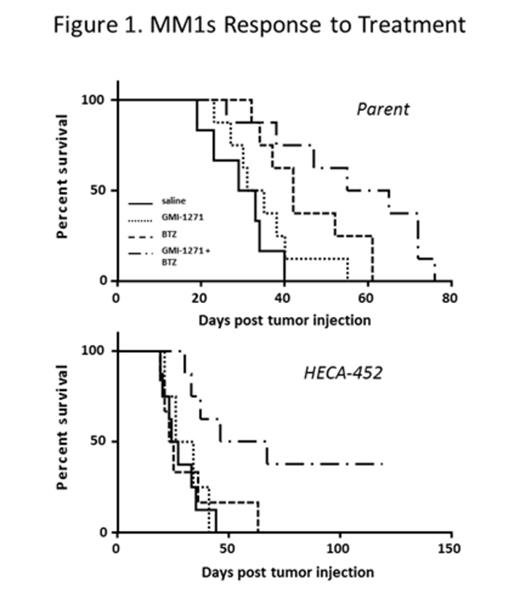Abstract
There is increasing evidence that E-selectin and its ligands play an important role in the progression of multiple myeloma (MM) and drug resistance. We reported that the sialyltransferase ST3GAL6 influences homing and survival in MM, and postulated that it may function in the synthesis of E-selectin ligands (Glavey et al Blood, 2014). We also found that a small subpopulation of cells (~ 5%) from MM cell lines express functional E-selectin ligands, which could be expanded under hypoxic conditions typical of the bone marrow (BM) microenvironment. These cells were identified by reactivity with an antibody (HECA452), which binds the same carbohydrate epitope required for binding to E-selectin. Rolling of MM1S cells on E-selectin was blocked by a small molecule glycomimetic antagonist to E-selectin (GMI-1271). Moreover, GMI-1271 significantly enhanced the anti-myeloma activity of bortezomib (BTZ) in an in vivo murine transplant model (Natoni et al Blood, 2014). We now extend these observations to obtain a more complete understanding of the role E-selectin plays in MM biology and chemotherapy resistance for its potential clinical relevance.
The parental, heterogeneous MM cell lines MM1S and RPMI8226 (MM1Spar, RPMI8226par, respectively) were sequentially sorted to obtain cell lines highly enriched (>85% and 80%) for the expression of cell surface carbohydrates bound by HECA452, and designated MM1SHECA452 and RPMI8226HECA452. The cell lines could be passaged in vitro and were stable for enriched E-selectin ligand expression. In contrast to parental cells, both MM1SHECA452 and RPMI8226HECA452 showed strong binding to E-selectin in static adhesion assays. Both MM1SHECA452 and RPMI8226HECA452 exhibited strong rolling on E-selectin under shear stress. MM1Spar or RPMI8226par failed to roll well on E-selectin. The addition of GMI-1271 during culture conditions led to a marked reduction in adhesion of MM1SHECA452 and profoundly inhibited rolling on E-selectin of both HECA452 enriched MM cell lines.
The significance of these in vitro findings was studied in vivo. MM1Spar or MM1SHECA452 cells were injected i.v. into SCID beige mice. Beginning 5 days post tumor injection, the survival impact of treatment with saline control, GMI-1271, BTZ or a combination of both was determined. Mice transplanted with MM1SHECA452 had more aggressive disease with significantly shorter survival compared to those transplanted with MM1Spar. In contrast to MM1Spar cells, mice engrafted with MM1SHECA452 demonstrated a marked resistance to BTZ treatment. Whereas GMI-1271 treatment alone had no impact on survival, the combination of GMI-1271 and BTZ led to a highly significant improvement in survival of MM1Spar engrafted mice (P=0.0363), and more importantly broke the resistance and restored the anti-myeloma activity of BTZ in MM1SHECA452 engrafted mice (P=0.0123) (figure 1). The number of peripheral blood (PB) human CD138+ cells was increased in MM1SHECA452-engrafted mice within 60 min following a single injection of GMI-1271, and persisted for at least 24 hours (2.37% v. 0.03%, p <0.001). This effect was consistent with GMI-1271 disrupting the tumor microenvironment and mobilizing MM1SHECA-452 cells from the BM niche.
Given these findings we wished to see if samples from patients with MM express E-selectin ligands and whether higher levels are seen with disease progression. BM and/or PB were obtained following informed consent from patients with MM and plasma cells (CD38+/CD138+) were analyzed for E-selectin ligand expression by flow cytometry using the HECA452 antibody. To date all primary MM samples (n=25) contained HECA452-reactive cell populations (median 22%). A consistently higher proportion of circulating MM cells express HECA452 when compared with paired BM samples (n=14), with a median difference of 33% (Wilcoxon signed rank test, p=0.02). HECA452 expression of MM in PB was significantly higher (on average 40% higher) in samples taken at relapse vs. diagnosis, (unpaired t test, p = 0.0008)
These data provide compelling evidence that E-selectin ligand bearing cells play an important role in disease progression and drug resistance in MM, and a strong rationale for clinical strategies incorporating GMI-1271 to improve patient outcome.
Smith:GlycoMimetics, Inc.: Employment. Locatelli-Hoops:GlycoMimetics, Inc.: Employment. Oliva:GlycoMimetics, Inc.: Employment. Fogler:GlycoMimetics, Inc.: Employment. Magnani:GlycoMimetics: Employment, Equity Ownership, Membership on an entity's Board of Directors or advisory committees. O'Dwyer:Celgene: Honoraria, Research Funding.
Author notes
Asterisk with author names denotes non-ASH members.


